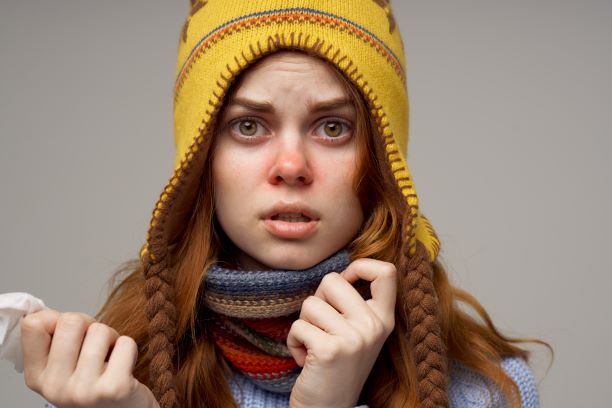During the fall and winter months, many people enjoy spending more time outdoors with friends and family for holiday events: viewing Christmas light displays, going to a parade, or enjoying family ski trips. All the time spent with friends and family or in the outdoors is a favorite part of the season for many people, but it also puts you at greater risk for cold and flu as well as leading to skin redness and inflammation from exposure to sun and cold. If you and Rudolph the Red Nosed Reindeer are starting to look a little too much alike, your dermatologist may be able to lend a hand. Dr. Aubrey Wagenseller of U.S. Dermatology Partners in Fairfax, Virginia, says, “There are many reasons you may have a red nose or general skin redness and inflammation, and many of these go hand-in-hand with the holiday season. When you understand what’s making your nose red, you can avoid the underlying causes. We can help with treatments to help lessen the symptoms of chronic skin conditions that lead to skin and nose redness.” Keep reading to learn a little more about red nose causes and treatment options from Dr. Wagenseller.
What Causes a Red Nose?
The best treatment for your nose redness will depend on the underlying cause of the condition. In most cases, the redness will clear up when we treat the cause, but first, we need to find it. Some of the most common reasons people experience red nose symptoms include:
Rosacea & Rhinophyma
Rosacea is a common, chronic skin condition that causes flushing, redness, small bumps, and increased blood vessel visibility. There are several subtypes of rosacea that have similar symptoms, but Rhinophyma is a subtype that can have a profound effect on the nose. Symptoms of rhinophyma include inflamed skin and bumps on the nose, the skin on the nose thickens, and the nose appears to grow larger or more bulbous. While the symptoms of other types of rosacea typically flareup and recede in cycles, rhinophyma is usually constant, and it gets worse over time without treatment.
Dry Skin & Irritation from Colds
Colds, the flu, upper respiratory infections, sinus infections, and other common illnesses will often lead to nasal drainage. This increases the number of times that you wipe or blow your nose each day. The constant irritation can leave your nose looking bright red.
Acne
The pores around the nose can easily become clogged, leading to acne breakouts. The breakouts themselves will often leave your nose looking red and inflamed, but if you pick at the acne, you may end up with scarred and reddened skin.
Windburn & Sunburn
When your face is exposed to the biting wind and sun in the winter months, you may find yourself dealing with burned, chapped, and reddened skin.
Allergic Reaction
There are two main types of allergic reactions that can cause a red nose – contact and perioral dermatitis. Contact dermatitis is the technical term for an allergic skin reaction that occurs through direct contact with an allergen. Perioral dermatitis usually occurs as a side effect of using topical medications, specifically steroidal creams.
Nasal Vestibulitis
Repeatedly blowing your nose due to nasal drainage from colds, allergies, and other conditions can lead to an infection inside your nostrils called nasal vestibulitis. This infection can leave your nose looking red and inflamed.
Spider Veins
Typically caused by repeated sun exposure, spider veins are often visible around the nose. These veins may become visible for people of any age, but they are most visible in older patients.
Lupus
Lupus is an autoimmune disease that causes the body to attack itself. While there are many adverse health effects associated with Lupus, one of the common characteristics of Lupus is a red, butterfly-shaped rash across the cheeks and nose.
How Can You Deal with Nose Redness?
Your treatment plan will be personalized to address your individual situation. Some treatment options for the most common causes of red nose listed above include:
Treatments for Rosacea & Rhinophyma
Depending on the severity, rosacea may be treatable using a topical ointment and making some lifestyle changes to avoid triggers and flare-ups. Witch hazel and menthol, common ingredients in many skincare and makeup products, are both known to trigger rosacea flareups, so you need to avoid using products with these ingredients. In most cases, those who develop rhinophyma have chronic rosacea that has not been properly managed. This more advanced form of rosacea typically requires extensive treatments, including laser therapy and skin resurfacing to smooth and reshape the nose.
Treatments for Dry Skin & Irritation from Colds
In most cases, skin dryness and irritation associated with colds and other health concerns will clear up once you get better. Make sure you’re staying hydrated, getting plenty of rest, and using gentle facial tissues. You can use aloe vera, petroleum jelly, and other mild moisturizers and creams to alleviate some irritation, protect the skin, and reduce redness.
Treatments for Acne
If you have acne that you treat regularly, you can usually use the same over the counter or prescription treatments for acne breakouts around your nose. In most cases, acne treatment plans include a combination of products with salicylic acid, benzoyl peroxide, and retinoid gel. Because the area around the nose is sensitive, these acne treatments can irritate the skin. Your dermatologist can help you find alternative treatments if regular acne products are too irritating to your nose.
Treatments for Windburn & Sunburn
Windburn and sunburn can be soothed using topical moisturizing lotions to encourage the skin to heal and relieve symptoms, including redness, throughout the process. Choose moisturizers that are light and fragrance-free to avoid additional irritation. You can also use products like aloe vera or Vitamin E oil to soothe and repair the skin.
Treatments for Allergic Reaction
Following an allergic reaction, you should wash your face with a gentle cleanser. In most cases, contact dermatitis can be cleared up using over the counter hydrocortisone cream. You may also want to use gentle moisturizers or soothing aloe vera ointments. Applying a cool, damp cloth can also help with redness.
For perioral dermatitis, the most important step is to forego the use of the product that lead to your flareup. Then, you should visit your doctor to receive a different product to treat the original condition that lead to the use of topical steroids. Additionally, we will recommend the use of an oral or topical anti-inflammatory product as well as topical moisturizers to soothe the skin and relieve redness.
Treatments for Nasal Vestibulitis
In most cases, we’ll prescribe a prescription mupirocin ointment that is applied directly to the infected areas. You can also use warm compresses to relieve discomfort and redness. If the infection continues or spreads, we will prescribe an oral antibiotic.
Treatments for Spider Veins
Spider veins can be treated with lasers in our office. The process is simple and very comfortable. Most people achieve their desired results in just one or two treatments.
Treatments for Lupus
Your dermatologist can help you develop a plan to address the redness on your face, but lupus requires diagnosis and advanced treatment plans with the help of multiple specialty practitioners. In order to maintain your results, you should continue all suggested treatments from your other healthcare providers as well as addressing the facial rash with products from a dermatologist.
How Can You Prevent Nose Redness?
According to Dr. Wagenseller, “As is the case with many skin conditions, your best defense may be a good offense. Keeping your skin clean and well hydrated every day is essential. Then, you can take a few steps to avoid irritating and inflaming your skin.” Some preventive recommendations include:
- Use heat & cold – alternate between using warm and cold compresses. This is a great way to prevent redness from swelling and irritation. If your nose regularly reddens, you can take some time to use cold compresses in the morning when you first wake up. Then, apply a cold compress for about 20 minutes before you go to bed.
- Avoid redness triggers – alcohol consumption, spicy foods, and even using a certain brand of facial tissue can all lead to nose redness. Avoiding or limiting exposure to these triggers can be beneficial to prevent a red nose.
- Use soft tissues – extra soft facial tissues can be beneficial to reduce redness if you have a cold or allergies leading to nasal drainage. You can also use petroleum jelly or healing ointments to keep your skin moisturized and prevent unnecessary irritation from repeated tissue use.
- Wear sunscreen – even though it’s cold outdoors, the sun can still damage your skin in the winter months, so make sure you’re applying sunscreen daily.
- Avoid chemicals – don’t expose the sensitive skin in and around your nose to unnecessarily harsh chemicals that irritate, inflame, and redden the skin. If you’ve recently changed skincare products or makeups, these new items may have caused the redness, so consider switching these.
- Don’t touch your nose – frequently touching your face and nose exposes this sensitive, porous skin to bacteria and debris on your hands and beneath your fingernails. This can lead to increased risk for infection, allergic response, and other concerns that cause redness.
Let U.S. Dermatology Partners Support Your Skin Health Goals
Let Rudolph be the one with the red nose! If you need help getting rid of skin inflammation that is causing a red nose or you just want to improve your general skin health, the knowledgeable professionals at U.S. Dermatology Partners are here to help. Dr. Wagenseller welcomes patients in Fairfax to reach out to schedule a visit. If you don’t live near Fairfax, one of our other practices may be a better option for you. To find the nearest office, simply complete our online request form. Then, one of our friendly team members will be in touch to iron out the details of your first appointment.
Find a location near me
or


